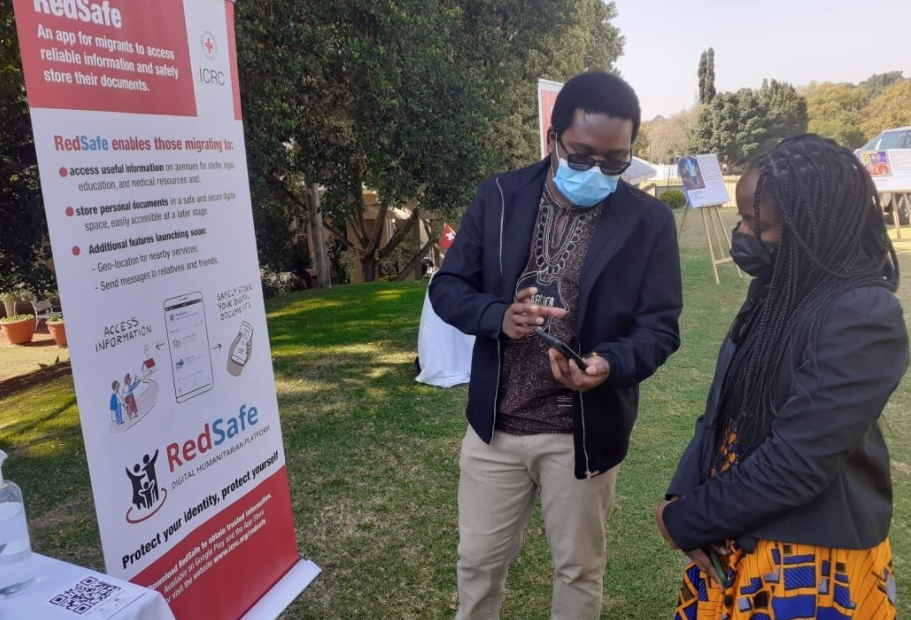RedSafe is a new digital humanitarian platform, built by the ICRC for the vulnerable people it serves, a tool for getting more services, to more people, more effectively. It is already being used to assist refugees and migrants, but it has potential to do so much more.
As the number of people needing protection and assistance worldwide spirals ever upwards, using digital means to reach – and be reached by – them is increasingly important. This is why the ICRC created RedSafe, a secure service delivery platform built, owned, and controlled by the ICRC. In an age of mass data collection and monetization, RedSafe is just that: safe.
The platform was first deployed this year, in Southern Africa, where it is providing reliable information and document storage facilities to migrants, via a free smartphone app, but this is just the start, says Balthasar Staehelin, Director of Digital Transformation and Data at the ICRC: “The platform could do anything, sky’s the limit!”
Security and Privacy
The ‘Information as AID’ function provides crucial, trusted, and vetted information useful to somebody forced to leave their home or their country, such as where to find shelter, food, healthcare, legal aid, assistance or protection, and which organizations work for migrants and refugees in a particular country. The app makes this information easy to access and allows the user control over what information they use and when.
The ‘Digital Vault’ function allows people to upload and safely store digital copies of their essential documents, such as passports, birth certificates or identity cards, in a cloud-type service with the data encrypted and held by the ICRC in Switzerland, where third parties cannot access it.
“The principle is, security and privacy by design,” says Romain Bircher, Leader of the Digital Platform Challenge Team. But it also had to work, and well. “If it’s not good enough, nobody will adopt it,” he says.
The aim was, and remains, ambitious, with the current uses just the start. “The objective is for RedSafe to be the main entry channel for people to connect with ICRC services and partner services—to ask for information and help remotely—but also a space to test services, and test new ways of delivering services, through the platform model,” says Bircher.
Upfront, Not Behind the Scenes
The ICRC’s digital strategy is seeing huge changes across the organization but, says Staehelin, much of this is behind the scenes. “We have a lot of projects where we harness digital technology to do what we do better, enhancing things under the hood, which is very important, but it doesn’t change things for the user.”
“RedSafe is a very different user experience, and really is the ICRC’s flagship project for offering new digital services,” he says.
Staehlin describes it as “a platform that allows us to plug in micro-services,” such as Information as AID and Digital Vault, but others will follow, as needs are identified in the field and solutions are built at headquarters. It is, he says, about “adding digital proximity to the existing physical proximity,” offering services when people need them, not only when ICRC delegates are present.
“It’s not a migrant platform, it is a tool that will allow us to have an impact in many of the situations where we are more present, such as conflicts.”
Field Testing, Field Learning
Trials in Southern Africa are proving the value of RedSafe, says Marie-Astrid Blondiaux, protection coordinator in Pretoria, who says “this concept is the missing piece of the puzzle” when it comes to reducing risks for migrants in the region.
The app has been downloaded 8,000 times since its launch in May 2021 (far exceeding Bircher’s expectation of perhaps 1,000 downloads in the first 12 months), the vast majority on Android rather than iOS devices. A recent deal with two of the region’s biggest telephone companies mean downloads of RedSafe will be reverse billed to the ICRC, increasing access for people who may lack phone credit, or a data package.
So far, it is the Information as AID service that is proving most popular among users, because “migrants lack information on what is out there for them,” says Blondiaux. By providing access to a raft of practical, essential information, migrants can be better prepared for what they may face, and therefore be less likely to require an emergency response further down the line.
“Our activities are mostly responses to migrants who have already faced risk—been separated, arrested, gone missing. I was looking for a solution, so that we are not just the ambulance coming to the rescue.”
Uptake of the Digital Vault has been slower as the ICRC strives to balance the competing demands of ease of use and data security, but Blandiaux says, the need is clear: “Migrants tell us they don’t take papers with them for fear they might get damaged, lost or stolen,” yet undocumented travel poses a whole host of other risks.
Meeting Expectations
Information as AID and Digital Vault both have their origins in needs identified among vulnerable populations through wide-ranging interviews conducted in Colombia, Greece, Kenya, South Africa and Zimbabwe. “It started with an understanding that people need to have access to trusted information to make the right decisions,” says Bircher, but it was also clear that refugees and migrants were often “very stressed about their legal status” so might find it useful to have saved copies of their identity documents.
“They need to be able to save their documents, retrieve them when they are safe, and also hide them when they don’t want to be identified,” says Bircher.
Digital Vault, then, is a specific solution to a specific challenge, but the RedSafe platform is a broader answer to a bigger question, says Bircher. “How do we meet the expectations of vulnerable people who are more and more connected? How do we meet the expectations, not only of donors, but of beneficiaries?”

